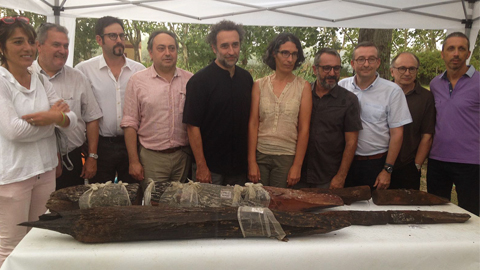International consolidation of La Draga's archaeological importance

21/07/2017
The most relevant results and new discoveries of the four-year project in archaeological research (2014-2017) of the Neolithic site of La Draga in Banyoles were presented on Friday 21 July. The work done by a multidisciplinary team formed by scientists from the Archaeological Museum of Catalonia, the Universitat Autònoma de Barcelona, the Spanish National Research Council (IMF) and the County Archaeological Museum of Banyoles has helped to learn yet more about the La Draga site and position it internationally as the only lakeside archaeological site of the Iberian peninsula and one of the earliest and most important of the Western Mediterranean.
The archaeological interventions conducted these past years cover a surface of 148 square metres and have allowed scientists to document the area in which different household activities, handicrafts and event ritual practices took place.
Among the most outstanding discoveries are the documenting of a workshop in which several ornamental objects were manufactured, such as beads and necklaces made with mollusc valves and a grave with several horned animal skulls, clearly representing some type of ritual. Often, the skulls of bulls and to a lesser extent that of other ruminants such as goats were manipulated to be exhibited as trophies or placed in special places.
The foundations of several homes, built 7,300 years ago, were also revealed. Over 150 pillars were recovered, some of them in a perfect state of conservation, and are evidence of an extremely meticulous work. These discoveries turn the site into a unique example of wooden architecture used by the first farming communities to settle on the banks of the Banyoles Lake. They are until now the only conserved examples of Neolithic constructions in all of the peninsula and one of the earliest in Europe.
The digs conducted have allowed scientists to document and extract the wooden pillars used to build cabins and other constructions in the first study and analysis of these elements, vital to the understanding of the La Draga settlement. The majority of pillars were made out of oak, a tree whose representation is currently minimal in the region surrounding the lake. The pillars will be sampled in order to genetically study the oaks, date them and characterise the process of elaboration.
Cultural Site of National Interest
Due to its singularity, the La Draga site is currently in the process of being declared a cultural site of national interest (BCIN) by the Government of Catalonia.
The importance of this prehistoric settlement lies in the fact that it was one of the first locations chosen by a Neolithic farming community to build a settlement in the north-east of the Iberian Peninsula some 7,300 years ago. The surrounding areas were then transformed to include agricultural and livestock activities needed to maintain the community. The most outstanding feature at the site is the conservation of elements built with wood and other organic materials, an exceptional feat for such an early society and which contributes to a more complete comprehension of these first farming and animal rearing communities.
Participating in the digs were some 200 people, among them students of the UAB bachelor's degree in Archaeology and students from other universities of Spain and Europe. In recent years, secondary school students from all over Catalonia have also participated in digs thanks to the UAB's ARGO programme.
Exhibition and Virtual Reconstruction at the Archaeological Museum of Catalonia
A sample of the discoveries made until now and the results of their analysis will be on display at the exhibition on the La Draga site of the Archaeological Museum of Catalonia, which will open to the public on 28 September. The exhibition will allow visitors for the first time to view original pieces created with organic materials, in addition to other objects, and a virtual reconstruction of the settlement thanks to a Recercaixa project funded by the Obra Social “La Caixa” and the Catalan Association of Public Universities (ACUP).
The large scientific impact and international projection achieved in recent years and the growing number of visitors to the site, has paved the way for a promising future for the research project and further dissemination of the activities conducted by the site.
Attending the presentation, which took place at the site, were Jordi Bosch, Culture Councillor of the Banyoles Town Council, and Elsa Ibar, General Deputy Director of Architectural, Archaeological and Palaeontological Heritage of the Department of Culture. Participating in the presentation were Josep Manuel Rueda, Director of the Archaeological Museum of Catalonia; Lluis Figueres, Director of the County Archaeological Museum of Banyoles - La Draga Neolithic Park; Carlos Sánchez,Vice-Rector for Institutional Relations and Culture at the UAB; and Xavier Terradas in representation of the CSIC-IMF. Following the press conference, the team of researchers invited guests to visit different areas of the site.
Dossier on the latest archaeological novelties found at La Draga (in Catalan)